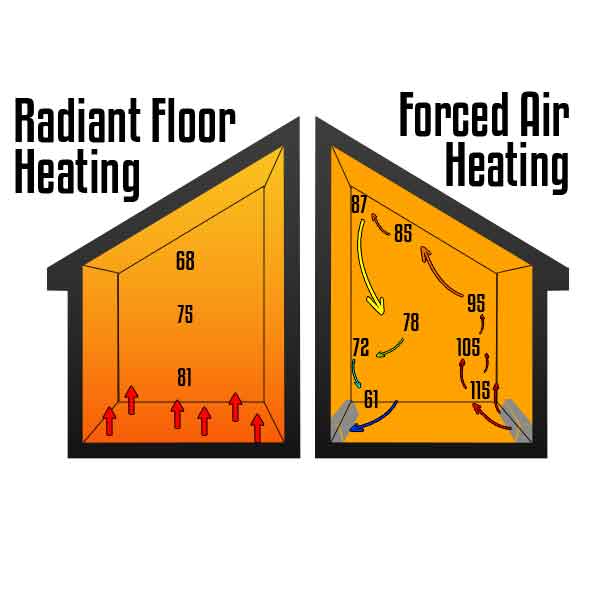Type of Heating Systems 
Forced air systems carry heat using air as a medium, most often through a series of ducts. On the other hand, radiant heat is typically distributed through a system of pipes filled with water. There are benefits to both types of systems, but to be able to make an educated decision, you need to learn about both.
Radiant Heat
If you’re looking for efficiency, radiant heat is your best bet. Some studies have put the efficiency of radiant heat at 30% greater than forced air. With a radiant system, it is easier to maintain a constant temperature in your home because it measures the temperature of the heated water in the pipes. With a forced air system, air temperatures in a home cool off quickly and drop below the set temperature, causing the heating system to run more cycles than a radiant system.
Radiant systems are also more efficient because they maintain heat within 6 feet of the floor, which is where you spend your time (I don’t think most of us spend much time, if any, on the ceilings of the rooms in our house). Radiant heating systems can keep the cooler temperatures up near the ceiling because they use infrared energy, which dissipates as it gets further from the source (like on the ceiling). The infrared energy also heats any objects in its direct line of sight. Those objects absorb the heat and then release it, causing a constant, even heat in your home. When you have radiators and in-floor warming delivering the heat, most of it stays closer to the floor where it is easier to enjoy.
Forced Air
On the other hand, with forced air systems, there is an opposite layering of temperatures. The hot air rises and hangs out near the ceiling, while cooler air settles towards the floor where we are spending our time.
Another benefit to radiant systems is that they keep your indoor air quality higher. Because they don’t move so much air around, which distributes allergens and dust, they’re better for you. But if it’s humidity you need during the dry winter months, forced air is your best bet. Paired with a humidifier, forced air can distribute humidity throughout your house, giving you relief from that winter dryness.
So why doesn’t everyone go with radiant heat? As you might have guessed, radiant heat is the more expensive option. A boiler and full-house radiant system costs more to purchase and install. Also, if you want air conditioning, you have to have ducting or separate split systems that are not compatible with radiant systems. Therefore, most people opt to “bundle” the heating and cooling system with a forced-air furnace system and air conditioner.
No matter which system you decide to install or repair, Baumann & DeGroot would be happy to talk through your options and take care of your needs.

Baumann & Degroot was founded in 1994 in West Michigan.
The post Forced Air & Radiant Heat appeared first on Baumann & DeGroot Heating & Cooling.

